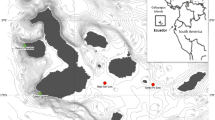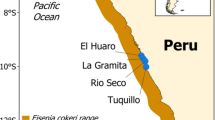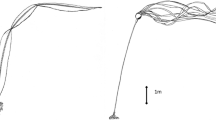Abstract
Kelps are ecosystem engineers and thus enhance biodiversity and subsidize food webs in nearshore areas. Numerous studies describing diversity and abundance of biota associated with kelp have focused on sub-tropical and temperate waters while kelp forests at high latitudes, where kelp is predicted to expand in distribution, remain mostly unexplored. Kelp forests contribute significantly to regional biodiversity, and associated fauna and the kelp themselves play ecologically important roles as habitat and feeding areas. Here, we report patterns in diversity, abundance and seasonal dynamics of fouling organisms associated with different regions of Saccharina latissima and nearby substrates (including stones of the barren ground). The study was conducted in Kongsfjorden, a high Arctic fjord on the west coast of Spitsbergen; and samples were taken five times between September 2013 and January 2015. Trends in species richness of epifauna were similar for stones and holdfasts: higher in winter (due the presence of rare species), and lower in spring and autumn. Species richness and abundance demonstrated a clear tendency to increase in accordance with substrate stability. Stones housed the most diverse biota compared to living substrates. Holdfasts demonstrated similar patterns in species composition and abundance as stones due their close spatial arrangement and presence of demersal larvae in most of fouling organisms. Similarly, assemblages on blades in prostrate kelp forests are influenced by the species inhabiting stones of the barren ground. Both biotic and abiotic factors, including habitat stability and proximity to source populations, contribute to these spatial and temporal patterns in faunal abundance and diversity.








Similar content being viewed by others
References
Anderson MJ, Diebelb CE, Blomb WM, Landers TJ (2005) Consistency and variation in kelp holdfast assemblages: spatial patterns of biodiversity for the major phyla at different taxonomic resolutions. J Exp Mar Biol Ecol 320:35–56. https://doi.org/10.1016/j.jembe.2004.12.023
Armitage CS, Sjøtun K (2016) Epiphytic macroalgae mediate the impact of a non-native alga on associated fauna. Hydrobiologia 776:35–49. https://doi.org/10.1007/s10750-016-2707-9
Arroyo NL, Maldonado M, Perez-Portela R, Benito J (2004) Distribution patterns of meiofauna associated with a sublittoral Laminaria bed in the Cantabrian Sea (north-eastern Atlantic). Mar Biol 144:231–242. https://doi.org/10.1007/s00227-003-1191-8
Atrill MJ, Ramsay PM, Rundle SD, Thomas RM, Trett MW (1996) An estuarine biodiversity hot-spot. J Mar Biol Ass UK 76:161–175. https://doi.org/10.1017/S002531540002909X
Barnes DKA, Kuklinski P (2003) High polar spatial competition: extreme hierarchies at extreme latitude. Mar Ecol Prog Ser 259:17–28
Berge J, Daase M, Renaud PE et al (2015) Unexpected levels of biological activity during the polar night offer new perspectives on a warming Arctic. Curr Biol 25:1–7
Berrill NJ (1930) Studies in tunicate development. Part I. General physiology of development of simple ascidians. Phil Trans Royal Soc Lond Ser B 218:37–78
Blight AJ, Thompson RC (2008) Epibiont species richness varies between holdfasts of a northern and a southerly distributed kelp species. J Mar Biol Assoc UK 88:469–475. https://doi.org/10.1017/S0025315408000994
Borum J, Pedersen MF, Krause-Jensen D, Christensen PB, Nielsen K (2002) Biomass, photosynthesis and growth of Laminaria saccharina in a high-arctic fjord, NE Greenland. Mar Biol 141:11–19. https://doi.org/10.1007/s00227-002-0806-9
Carlsen BP, Johnsen G, Berge J, Kuklinski P (2007) Biodiversity patterns of macro-epifauna on different lamina parts of Laminaria digitata and Saccharina latissima collected during spring and summer 2004 in Kongsfjorden, Svalbard. Polar Biol 30:939–943. https://doi.org/10.1007/s00300-007-0272-4
Christie H, Jørgensen NM, Norderhaug KM, Waage-Nielsen E (2003) Species distribution and habitat exploitation of fauna associated with kelp (Laminaria hyperborea) along the Norwegian coast J Mar Biol Ass UK 83:687–699. https://doi.org/10.1017/s0025315403007653h
Christie H, Norderhaug KM, Fredriksen S (2009) Macrophytes as habitat for fauna. Mar Ecol Progr Ser 396:221–234
Cottier FR, Tverberg V, Inall ME, Svendsen H, Nilsen F, Griffiths C (2005) Water mass modification in an Arctic fjord through cross-shelf exchange: the seasonal hydrography of Kongsfjord, Svalbard. J Geophys Res Oceans 110:c12005. https://doi.org/10.1029/2004JC002757
Dean RL, Connell JH (1987) Marine invertebrates in an algal succession III. Mechanisms linking habitat complexity with diversity. J Exp Mar Biol Ecol 109:249–273. https://doi.org/10.1016/0022-0981(87)90057-8
Denisenko NV (1983) On the method of assessing biomass of bryozoans. Zoologicheskii zhurnal (Russian journal of zoology) 62:1729–1731 (in Russian)
Duggins DO, Eckman JE, Sewell AT (1990) Ecology of understory kelp environments. II. Effects of kelps on recruitment of benthic invertebrates. J Exp Mar Biol Ecol 143:27–45. https://doi.org/10.1016/0022-0981(90)90109-P
Edwards A (1980) Ecological studies of the kelp, Laminaria hyperborea, and its associated fauna in South-West Ireland. Ophelia 19:47–60. https://doi.org/10.1080/00785326.1980.10425506
Eleftheriou A (2013) Methods for the study of marine benthos. Wiley
Ereskovsky A (2010) The comparative embryology of sponges. Springer Science & Business Media
Gee JM (1963) Pelagic life of Spirorbis larvae. Nature 198:1109–1110
Gee JM, Warwick RM (1994) Metazoan community structure in relation to the fractal dimensions of marine macroalgae. Mar Ecol Progr Ser 103:141–150
Gerrodette T (1981) Dispersal of the solitary coral Balanophyllia elegans by demersal planular larvae. Ecology 62:611–619. https://doi.org/10.2307/1937728
Gomez I, Wulff A, Roleda MY, Huovinen P, Karsten U, Quartino ML, Dunton K, Wiencke C (2009) Light and temperature demands of marine benthic microalgae and seaweeds in polar regions. Bot Mar 52:593–608. https://doi.org/10.1515/BOT.2009.073
Grenvald JC, Callesen TA, Daase M, Hobbs L, Darnis G, Renaud PE, Cottier F, Nielsen TG, Berge J (2016) Plankton community composition and vertical migration during polar night in Kongsfjorden. Polar Biol 39:1879–1895. https://doi.org/10.1007/s00300-016-2015-x
Grzelak K, Kuklinski P (2010) Benthic assemblages associated with rocks in a brackish environment of the southern Baltic Sea. J Mar Biol Ass UK 90:115–124. https://doi.org/10.1017/S0025315409991378
Hellio C, Bremer G, Pons AM, Le Gal Y, Bourgougnon N (2000) Inhibition of the development of microorganisms (bacteria and fungi) by extracts of marine algae from Brittany, France. Appl Microbiol Biotechnol 54:543–549. https://doi.org/10.1007/s002530000413
Hellio C, Berge JP, Beaupoil C, Le Gal Y, Bourgougnon N (2002) Screening of marine algal extracts for anti-settlement activities against microalgae and macroalgae. Biofouling 18:205–215. https://doi.org/10.1080/08927010290010137
Hornsey IS, Hide D (1976) The production of antimicrobial compounds by British marine algae III. Distribution of antimicrobial activity within the algal thallus, Brit Phycol Journ 11:175–181. https://doi.org/10.1080/00071617600650201
Jones CG, Lawton JH, Shachak M (1994) Organisms as ecosystem engineers. Ecosystem management. Springer, New York, pp 130–147
Jost L (2006) Entropy and diversity. Oikos 113:363–375. https://doi.org/10.1111/j.2006.0030-1299.14714.x
Kain JM (1971) Synopsis of the biological data on Laminaria hyperborea. F.A.O. Fish. Synopsis 87:1–68
Kain JM, Jones NS (1963) Aspects of the biology of Laminaria hyperborean II. Age, weight and length. J Mar Biol Ass UK 43:129–151. https://doi.org/10.1017/S0025315400005312
Kelaher BP, Castilla JC (2005) Habitat characteristics influence macrofaunal communities in coralline turf more than mesoscale upwelling on the coast of Northern Chile. Estuar Coast Shelf Sci 63:155–165. https://doi.org/10.1016/j.ecss.2004.10.017
Knight-Jones EW (1951) Gregariousness and some other aspects of the setting behaviour of Spirorbis. J Mar Biol Assoc UK 30:201–222. https://doi.org/10.1017/S0025315400012716
Knight-Jones EW (1953) Decreased discrimination during setting after prolonged planktonic life in larvae of Spirorbis borealis (Serpulidae). J Mar Biol Assoc UK 32:337–345. https://doi.org/10.1017/S0025315400014594
Knowles LL, Bell S (1998) The influence of habitat structure in faunal-habitat associations in a Tampa Bay seagrass system, Florida. Bull Mar Sci 62:781–794
Kovalenko KE, Thomaz SM, Warfe DM (2012) Habitat complexity: approaches and future directions. Hydrobiologia 685:1–17. https://doi.org/10.1007/s10750-011-0974-z
Krause-Jensen D, Marba N, Olesen B et al (2012) Seasonal sea ice cover as principal driver of spatial and temporal variation in depth extension and annual production of kelp in Greenland. Glob Change Biol 18:2981–2994. https://doi.org/10.1111/j.1365-2486.2012.02765.x
Kuklinski P (2009) Ecology of stone-encrusting organisms in the Greenland Sea—a review. Polar Res 28:222–237. https://doi.org/10.1111/j.1751-8369.2009.00105.x
Kuklinski P, Barnes DKA (2005) Microhabitat diversity of Svalbard Bryozoa. J Nat Hist 39:539–554. https://doi.org/10.1080/00222930400001350
Kuklinski P, Gulliksen B, Lønne OJ, Weslawski JM (2006) Substratum as a structuring influence on assemblages of Arctic bryozoans. Polar Biol 29:652–661. https://doi.org/10.1007/s00300-005-0102-5
Kuklinski P, Berge J, McFadden L, Dmoch K, Zajaczkowski M, Nygård H, Piwosz K, Tatarek A (2013) Seasonality of occurrence and recruitment of Arctic marine benthic invertebrate larvae in relation to environmental variables. Polar Biol 36:549–560. https://doi.org/10.1007/s00300-012-1283-3
Kupriyanova EK, Nishi E, Ten Hove HA, Rzhavsky AV (2001) Life-history pattern in serpulimorph polychaetes: ecological and evolutionary perspectives. Oceanogran Mar Biol Ann Rev 39:1–101
Leclerc J-C, Riera P, Laurans M, Leroux C, Lévêque L, Davoult D (2015) Community, trophic structure and functioning in two contrasting Laminaria hyperborea forests. Estuar Coast Shelf Sci 152:11–22. https://doi.org/10.1016/j.ecss.2014.11.005
Lippert H, Iken K, Rachor E, Wiencke C (2001) Macrofauna associated with macroalgae in Kongsfjord (Spitsbergen). Polar Biol 24:512–522. https://doi.org/10.1007/s003000100250
Loke LHL, Todd PA (2016) Structural complexity and component type increase intertidal biodiversity independently of area. Ecology 97:383–393. https://doi.org/10.1890/15-0257.1
Lund S (1959) The marine algae of East Greenland. I. Taxonomical part. Meddelelser om Grønland 156:1–244
Lüning K (1979) Growth strategies of three Laminaria species (Phaeophyceae) inhabiting different depth zones in the sublittoral region of Helgoland (North Sea). Mar Ecol Progr Ser 1:195–201
Lüning K (1990) Seaweeds: Their environment, biogeography and ecophysiology. John Wiley & Sons
Lüning K (1993) Environmental and internal control of seasonal growth in seaweeds. Hydrobiologia 260–261:1–14. https://doi.org/10.1007/BF00048997
Makarov VN, Schoschina EV (1996) Dynamics and seasonal growth strategies of the brown alga Laminaria saccharina in the Barents Sea. Biologiya Morya (Vladivostok) 22:238–248 (in Russian)
Matias MG, Underwood AJ, Hochuli DF, Coleman RA (2010) Independent effects of patch size and structural complexity on diversity of benthic macroinvertebrates. Ecology 91:1908–1915. https://doi.org/10.1890/09-1083.1
McCoy ED, Bell SS (1991) Habitat structure: the evolution and diversification of a complex topic. Habitat structure. Springer, Dordrecht, pp 3–27
Meyer K, Sweetman A, Kuklinski P, Leopold P, Vogedes D, Berge J, Griffiths C, Young C, Renaud P (2017) Recruitment of benthic invertebrates in high Arctic fjords: relation to temperature, depth and season. Limnol Oceanogr 62:2732–2744. https://doi.org/10.1002/lno.10602
Migotto AE (1998) The life cycle of Sertularia marginata Kirchenpauer, 1864 (Cnidaria: Hydrozoa): a medusoid-producing sertulariid. J Nat Hist 32:1–12. https://doi.org/10.1080/00222939800770011
Miguel G, Matias MG, Underwood AJ, Hochuli DF, Coleman RA (2010) Independent effects of patch size and structural complexity on diversity of benthic macroinvertebrates. Ecology 91:1908–1915
Mileikovsky SA (1971) Types of larval development in marine bottom invertebrates, their distribution and ecological significance: a re-evaluation. Mar Biol 10:193–213. https://doi.org/10.1007/BF00352809
Norderhaug KM, Christie H, Fredriksen S (2007) Is habitat size an important factor for faunal abundances on kelp (Laminaria hyperborea)? J Sea Res 58:120–124. https://doi.org/10.1016/j.seares.2007.03.001
Norton TA (1971) An ecological study of the fauna inhabiting the sublittoral marine alga Saccorhiza polyschides (Lightf.) Batt. Hydrobiologia 37:215–231. https://doi.org/10.1007/BF00015570
Orlov D (1996) Observations on the settling behaviour of planulae of Clava multicornis Forskål (Hydroidea, Athecata). Sci Mar 60:121–128
Orlov DV (1997) The role of larval settling behaviour in determination of the specific habitat of the hydrozoan Dynamena pumila (L.) larval settlement in Dynamena pumila (L.). J Exp Mar Biol Ecol 208:73–85. https://doi.org/10.1016/S0022-0981(96)02673-1
Osman RW (1977) The establishment and development of a marine epifaunal community. Ecol Monogr 47:37–63. https://doi.org/10.2307/1942223
Parker JD, Emmett DJ, Orth RJ (2001) Plant species diversity and composition: experimental effects on marine epifauna assemblages. Mar Ecol Progr Ser 224:55–67
Pearse JS (1969) Slow developing demersal embryos and larvae of the Antarctic sea star Odontaster validus. Mar Biol 3:110–116. https://doi.org/10.1007/BF00353429
Piwosz K, Walkusz W, Hapter R, Wieczorek P, Hop H, Wiktor J (2009) Comparison of productivity and phytoplankton in a warm (Kongsfjorden) and a cold (Hornsund) Spitsbergen fjord in midsummer 2002. Polar Biol 32:549–559. https://doi.org/10.1007/s00300-008-0549-2
Reed G (1991) Bryozoa. In: Giese AC, Pearse JC, Pearse VB (eds.) Reproduction of marine invertebrates. Vol VI. Echinoderms and Lophophorates. Pacific Grove: Boxwood Press, pp 85–245
Reed DC, Nelson JC, Harrer SL, Miller RJ (2016) Estimating biomass of benthic kelp forest invertebrates from body size and percent cover data. Mar Biol 163:101. https://doi.org/10.1007/s00227-016-2879-x
Rozycki O, Gruszczynski M (1986) Macrofauna associated with laminarians in the coastal waters of West Spitsbergen. Polish Polar Res 7:337–351
Ryland JS (1974) Behaviour, settlement and metamorphosis of bryozoan larvae: a review. Thalassia Jugosl. 10:239–262
Ryland JS (1976) Physiology and ecology of marine bryozoans. In: Russel F S, Yonge M (eds.) Advances in marine biology. Academic Press, pp 285–443
Schaffelke B, Lüning K (1994) A circannual rhythm controls seasonal growth in the kelps Laminaria hyperborea and L. digitata from Helgoland (North Sea). Eur J Phycol 29:49–56. https://doi.org/10.1080/09670269400650471
Schultze K, Janke K, Krüß A, Weidemann W (1990) The macrofauna and macroflora associated with Laminaria diffitata and L. hyperborea at the island of Helgoland (German Bight, North Sea) Helgol Meeresunters 44:39–51. https://doi.org/10.1007/bf02365430
Seed R, Harris S (1980) The epifauna of the fronds of Laminaria digitata Lamour in Strangford Lough, Northern Ireland. Proc R Ir Acad 80:91–106
Seed R, O’Connor RJ (1981) Community organization in marine algal epifauna. Annu Rev Ecol Syst 12:49–74
Sheppard CRC, Bellamy DJ, Sheppard ALS (1977) The fauna associated with Laminaria ochroleuca Pyl. In the Straits of Messina. Memorie di Biologia Marina edi Ocenografia 7:1–9
Shimeta J, Jumars PA (1991) Physical mechanisms and rates of particle capture by suspension feeders. Oceanogr Mar Biol Annu Rev 29:191–257
Smith SDA (1996) The macrofaunal community of Ecklonia radiata holdfasts: variation associated with sediment regime, sponge cover and depth. Aust J Ecol 21:144–153
Smith SDA, Simpson RD, Cairns SC (1996) The macrofaunal community of Ecklonia radiata holdfasts: description of the faunal assemblage and variation associated with differences in holdfast volume. Aust J Ecol 21:81–95. https://doi.org/10.1111/j.1442-9993.1996.tb00587.x
Sommer C (1992) Larval biology and dispersal of Eudendrium racemosum (Hydrozoa, Eudendriidae). In: Bouillon J, Boero F, Cicogna F, Gili JM, Hughes RG (eds) Aspects of hydrozoan biology. Sci Mar 56:205–211
Sousa WP (1979) Disturbance in marine intertidal boulder fields: the nonequilibrium maintenance of species diversity. Ecology 60:1225–1239. https://doi.org/10.2307/1936969
Spurkland T, Iken K (2011) Kelp bed dynamics in estuarine environments in subarctic Alaska. J Coastal Res 27:133–143. https://doi.org/10.2112/JCOASTRES-D-10-00194.1
St. Pierre JI, Kovalenko KE (2014) Effect of habitat complexity attributes on species richness. Ecosphere 5:1–10. https://doi.org/10.1890/ES13-00323.1
Steneck RS, Graham MH, Bourque BJ, Corbett D, Erlandson JM, Estes JA, Tegner MJ (2002) Kelp forest ecosystems: biodiversity, stability, resilience and future. Environ Conserv 29:436–459. https://doi.org/10.1017/S0376892902000322
Stübner EI, Søreide JE, Reigstad M, Marquardt M, Blachowiak-Samolyk K (2016) Year-round meroplankton dynamics in high-Arctic Svalbard. J Plankton Res 38:522–536. https://doi.org/10.1093/plankt/fbv124
Svane I, Young CM (1989) The ecology and behavior of ascidian larvae. Oceanogr Mar Biol Annu Rev 27:45–90
Svendsen H, Beszczynska-Møller A, Hagen JO, Lefauconnier B, Tverberg V, Gerland S, Ørbæk JB, Bischof K, Papucci C, Zajaczkowski M, Azzolini R, Bruland O, Wiencke C, Winther J-G, Dallmann W (2002) The physical environment of Kongsfjorden–Krossfjorden, an Arctic fjord system in Svalbard. Polar Res 21:133–166
Villegas MJ, Laudien J, Sielfeld W, Arntz WE (2008) Macrocystis integrifolia and Lessonia trabeculata (Laminariales; Phaeophyceae) kelp habitat structures and associated macrobenthic community off northern Chile. Helgol Mar Res 62:33–43. https://doi.org/10.1007/s10152-007-0096-1
Vogel S (1994) Life in moving fluids. Princeton University Press
Walkusz W, Kwasniewski S, Falk-Petersen S, Hop H, Tverberg V, Wieczorek P, Weslawski JM (2009) Seasonal and spatial changes in the zooplankton community of Kongsfjorden, Svalbard. Polar Res 28:254–281. https://doi.org/10.1111/j.1751-8369.2009.00107.x
Ward MA, Thorpe JP (1989) Assessment of space utilization in a subtidal temperate bryozoan community. Mar Biol 103:215–224. https://doi.org/10.1007/BF00543350
Wiencke C, Amsler DC (2012) Seaweeds and their communities in polar regions. Seaweed Biology. Springer, Berlin, pp 265–291
Wiencke C, Clayton MN, Gomez I, Iken K, Lüder UH, Amsler CD, Karsten U, Hanelt D, Bischof K, Dunton K (2007) Life strategy, ecophysiology and ecology of seaweeds in polar waters Rev Environ Sci. Biotechnol 6:96–126. https://doi.org/10.1007/s11157-006-9106-z
Wiencke C, Gomez I, Dunton K (2009) Phenology and seasonal biological performance of polar seaweeds. Bot Mar 52:585–592. https://doi.org/10.1515/BOT.2009.078
Williams GB (1965) Observations on the behaviour of the planulae larvae of Clava squamata. Helgoländer Meeresun 45:257–273. https://doi.org/10.1017/S0025315400004112
Willis K, Cottier F, Kwasniewski S, Wold A, Falk-Petersen S (2006) The influence of advection on zooplankton community composition in an Arctic fjord (Kongsfjorden, Svalbard). J Mar Syst 61:39–54. https://doi.org/10.1016/j.jmarsys.2005.11.013
Wilson MA (1987) Ecological dynamics on pebbles, cobbles, and boulders. Palaios 2:594–599. https://doi.org/10.2307/3514495
Withers RG, Farnham WF, Lewey S, Jephson NA, Haythorn JM, Gray PWG (1975) The Epibionts of Sargassum muticum in British Waters. Mar Biol 31:79–86. https://doi.org/10.1007/BF00390650
Wlodarska-Kowalczuk M, Kuklijski P, Ronowicz M, Legeryjska J, Gromisz S (2009) Assessing species richness of macrofauna associated with macroalgae in Arctic kelp forests (Hornsund, Svalbard). Polar Biol 32:897–905. https://doi.org/10.1007/s00300-009-0590-9
Yakovis EL, Artemieva AV, Shunatova NN, Varfolomeeva MA (2008) Multiple foundation species shape benthic habitat islands. Oecologia 155:785–795. https://doi.org/10.1007/s00442-007-0945-2
Acknowledgements
We would like to thank the staff of Kings Bay AS (Ny-Ålesund, Svalbard) for hospitality. Special thanks to Daniel Vogedes, Peter Leopold, Rupert Krapp and Carl Ballantine for their assistance in sampling. We are grateful to Marina Varfolomeeva for her support with data analysis. This study was funded by Norwegian Research Council grant Marine Night (Project Number NRC 226417) and partly by Saint-Petersburg State University project 1.42.1277.2014.
Author information
Authors and Affiliations
Corresponding author
Ethics declarations
Conflict of interest
The authors declare that they have no conflict of interest.
Ethical approval
All applicable international, national, and/or institutional guidelines for the care and use of animals were followed.
Electronic supplementary material
Below is the link to the electronic supplementary material.
Rights and permissions
About this article
Cite this article
Shunatova, N., Nikishina, D., Ivanov, M. et al. The longer the better: the effect of substrate on sessile biota in Arctic kelp forests. Polar Biol 41, 993–1011 (2018). https://doi.org/10.1007/s00300-018-2263-z
Received:
Revised:
Accepted:
Published:
Issue Date:
DOI: https://doi.org/10.1007/s00300-018-2263-z




